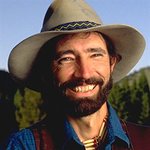Jim Stoltz – better known as “Walkin’ Jim”, a world-renown American explorer honored by the Environmental Protection Agency for his efforts to help save endangered animal species – passed away recently after a long battle with cancer.
The 57-year-old folk singer-songwriter, photographer, poet, storyteller, author and conservationist hiked more than 28,000 miles of rugged North American wilderness, crossing raging rivers, mountain ranges, vast deserts, dense forests and canyon lands from the Appalachians to the Olympics and from Mexico to Canada. When he wasn’t exploring, he was using his rich baritone voice to share original heartfelt songs, poems and stories “from the wild places” to children of all ages. His love and concern for animals and the habitats where they thrived inspired founding of the organization Musicians United to Sustain the Environment.
“Jim was one of those bigger-than-life men who literally ‘walked his talk’ — traversing thousands of miles of backcountry and countless musical tours living out his ‘Forever Wild’ theme,” said fellow folk artist and conservationist Craig Wagner, who co-founded MUSE with “Walkin’ Jim” in 1998. “We at MUSE feel privileged to be the steward of his legacy of music, poetry, photography and vision — a vision of sustaining those ‘Wild’ parts of our environment for generations to come.”
His love of the outdoors began early in life. He and his sister, Susan Grace Stoltz, spent their childhood summers at their grandparents’ lakeside home in rural northern Michigan, swimming, reading books, hiking, and exploring through dense forests of maple, pine and bracken fern. A scoutmaster (Mr. Birch) planted the seed of adventure by teaching him how to hike in the wilderness, set up camp, build a campfire, and observe animals in the wild.
“‘Walkin’ Jim’ was not only a hero to me, but he was a true American folk hero — right up there with Woody Guthrie and Pete Seeger,” said Susan, who lives in Fairbanks, Alaska. “He brought natural history to life by sharing stories and songs from his experiences. He spoke out and sang for all of those special places in North America, which have no voice. My brother, Jim, made a difference with his life.”
A chance meeting with a hiker on the Appalachian Trail in Virginia would forever change him. Deeply inspired by the hiker’s stories, “Walkin’ Jim” began planning a trip of his own. In 1974, the then 23-year-old hiked the Appalachian mountain range from Springer Mountain, Ga., to Mt. Khatadin, Maine.
“This was the coming of age trip that shaped his life and started it all,” Susan added.
The following year, he embarked on an even-more-adventurous trek, crossing America from the most eastern point (West Quoddy Head, Maine) to the most western point (Cape Alava, Wash.) In the ensuing years, he completed the Pacific Crest Trail; the Continental Divide Trail from Mexico to Canada; his own route through Arizona, Utah, Idaho and Montana; and the Rocky Mountain spine from Yellowstone National Park to the Yukon. He also took numerous long hikes in the Nevada wilderness.
His explorations did not come without risk. During one alpine hike, Jim lost his footing while crossing a frozen snow patch and began sliding down the slippery ice toward a “huge drop-off”. His old Stella guitar, which was always strapped to his backpack, saved his life.
“His hands were bloody from trying to dig into the snow and stop sliding toward sure death”, Susan recalled him telling her. “He finally rolled over on his back in an effort to see where he was going as he drew closer to the cliff edge. Jim often said he ‘wanted to see the view if he was going to fall to his death’. When he rolled over, the neck of his guitar dug into the snow, and he found himself dangling by his shoulder straps looking at the edge of the cliff. It was a close call.”
The artist’s outdoor adventures and interactions with wild animals inspired him to write countless songs, poems and stories, which he shared with thousands of fans across North America. Children adored him, marveling at his stories and dreaming that they, too, would one day hike the rugged North American wilderness. To help pay the bills, he spent 30 winters driving horse-drawn sleighs and performing at Lone Mountain Ranch in Big Sky, Montana. He rarely turned down an invitation to perform for conservation organizations, sharing their passion for the protection of predatory animals such as wolves and grizzlies or halting the clear cutting of mountain forests.
His song, “Mornin’ in the Mountains”, was inspired by a breathtaking sunrise in the mountains of Colorado in 1989. “Friends Along the Way” reflects his gratitude for the people who enriched his life. “Forever Wild” serves as his anthem for the wild places. Children enjoyed singing along to “The Web of Life”, “Big Fat Fish” and “Pika Pika”.
Jim was resting along a mountain trail when he wrote the classic “Forever Wild”. His lyric reads: “There’s a magic in the air, that I feel when I am there… It plays straight to the heart, and lays it all to bare… It’s in the cry of the eagle, and the deer so meek and mild… It’s in the rise of the mountain, let it stay forever wild.”
“He used his distinctive baritone vocals to convey the essence of the natural world, something that only a few people ever experience in real life,” said close friend and former wife Leslie Stoltz. “His words spoke loud and clear. Listeners were taken by his passion. There were a lot of tears at his shows.”
Jim used his ballads to share vivid images from the past. He sang about blueberry pickers in northern Michigan, famous bank robber Silver Jack, and mountain men from the West. Miners, conservationists and diverse people from all walks of life loved his “Ballad of Willie and Millie”, a song about an older couple remembering how they fell in love at Columbia Gardens amusement park near Butte, Montana. A mining company tore it down in 1973.
Many of the songs “Walkin’ Jim” wrote while on his long-distance treks can be heard on his eight albums: “Spirit Is Still On The Run”, “Forever Wild”, “Listen to the Earth”, “The Vision”, “Little Piece of Time”, “The Long Trails?”, “Oh What a Life”, “A Kid for the Wild” (for children), “The Web of Life” (for children), and “Come Walk With Me” (a Children’s DVD). Individuals can hear and/or order his recordings at www.walkinjim.com.
In 2003, the artist wrote a book about “his long walk” across rugged southwest Montana titled “Walking with the Wild Wind”. The book also reflects on other experiences in his life.
After hiking thousands of miles of wilderness, Jim set his sights on helping protect the mountains, glaciers, trees and animals that he loved. He helped in the planning and design of several trails throughout the Southwest, including a short segment in northern Arizona the U.S. Forest Service named the “Walkin’ Jim Trail”. He lobbied the U.S. Congress to pass the Northern Rockies Ecosystem Protection Act, later receiving an award from the EPA for his efforts to protect endangered animal species.
“Seriously, this is a beautiful Earth we live upon”, Jim wrote in one of his journal entries. “I have spent my life trying to share that beauty. But a large part of that beauty is unseen. It is the intertwined strands that tie us all together, from the tiniest microbes in the soil to the biggest tree in the forest. We all belong. We all depend on each living thing. We all depend on each other!”
Several years before he died, he embarked on a 50-state tour to share his “Forever Wild” message. He later contributed songs for three MUSE-sponsored CDs, with 100 percent of the proceeds supporting grass roots environmental organizations. The albums also feature cuts by contemporaries such as Pete Seeger, Libby Roderick, Dakota Sid Clifford, Joyce Rouse (Earth Mama) and Craig Wagner.
“He could shift from a solo walk of hundreds of miles to an East or West Coast tour that engaged thousands of people with his articulate defense of natural landscape and threatened species,” said MUSE board member Joyce Rouse. “His perfectly crafted songs inspired by the experience of long solo hikes, and the spectacular backcountry slides accompanying the songs, often rendered audiences speechless, then inspired them to work for a healthy eco-system. Jim was a friend, a mentor, and an inspiration for so many people.”
In 2008, “Walkin’ Jim” emerged after recovering from winter-long chemotherapy to take a six-week hike along 460 miles of the Idaho/Montana state line. It would be one of his last long-distance hikes.
“I regained the 30 pounds I lost, but then I went on a long walk and lost 20 again,” he reported in his newsletter, Wild Wind. “It was mostly ridge-walking through some incredible mountain ranges and was such a perfect route for a long trek…. The last day found me walking the ridge north from Northwestern Peak to the Canadian border. There isn’t a trail, but the ridge is easy to walk up to Burke Mountain. I traversed a rocky section and then entered broad open meadows hung over the crest of the mountain. They were full of lupine, and the sun started to break through the clouds, setting them all aglow. My steps became light as I realized that this was the place I’d seen myself all those months ago during the radiation treatments. I felt such joy. Such hope. Such gratitude. Tears filled my eyes, and I just sobbed in thankfulness as my legs carried me up to that last rock-covered peak. It was an unforgettable moment that I’ll carry with me forever.”
“Walkin’ Jim” Stoltz is survived by his friend and former wife Leslie Stoltz of Big Sky, Montana; brother Mark Stoltz of Honor, Mich.; and sisters Susan Grace Stoltz of Fairbanks, Alaska, and Lisa Mohr of Wixom, Mich.


